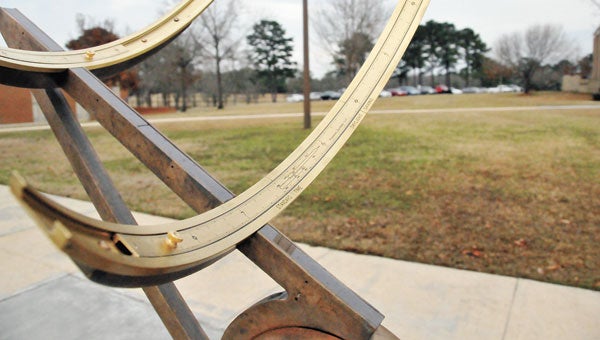Ancient technology: LBW adds sundial
Published 12:13 am Thursday, February 27, 2014

This is a focusing sun dial custom made for its location on the LBW campus by Precision Sundials in Vermont. The earliest sundials date back to 3500 B.C.
As of Wednesday morning, a new, eye-catching item has been added to the grounds of Lurleen B. Wallace Community College in Andalusia, but President Dr. Herb Riedel says there is much more to the addition than what meets they eye.
“I have long been interested in sundials,” Riedel said. “I have found that it is a device used for practical purposes to keep time, but they also take on a symbolic meeting. For a college campus, I thought it would be very appropriate because it combines science and art.”
Riedel said his fascination with sundials began years ago during a South Carolina winter, when the sun was seldom seen.
“I really started thinking about the sun,” he said. “It’s a reminder that we, as human beings, are inhabitants of one planet. It reminds us of how we’re all connected.”
Riedel said it was with those thoughts in mind that he began a search for one of the instruments – but not just any sundial would suffice.
Most sundials, he said, show “solar” time, not accounting for time zones. Riedel said he had something a bit more accurate in mind.
“This particular sun dial will accurately show the time up to the minute,” he said. “Most show accurate solar time. But we all use standard time these days in time zones. This sundial even has an adjustment that will allow us to read the actual clock time, even during daylight savings. It’s a precise scientific instrument.”
Riedel said another aspect of the dial that makes it unique is also very pleasing to the eye.
“This is a focusing sun dial, so instead of shadow, it focuses the sun’s light into a beam and onto a brass scale that has the minute line engraved on it,” he said.
Riedel said LBW’s sundial was custom made by Bill Gottesman, an artesian with the company Precision Sundials in Vermont.
“Gottesman is an artesian and a sundial expert,” Riedel said. “What makes this sundial unique is the location. It is custom made for our precise location of 31 degrees, 19 minutes, 19 seconds north latitude and 86 degrees, 27 minutes, 4 seconds west longitude. If somebody were to take this sundial somewhere else, it would not be precise.”
Riedel said the acquisition of the sundial also required funding, which came in the form of a donation from Montgomery architect Renis O. Jones Jr.
“We agreed on an amount and he paid half last year and he actually presented me with a check for the other half this morning,” he said Wednesday.
In addition to providing a home for the new instrument, Riedel said the Andalusia campus of LBW also provided the base it rests upon.
“I’m very pleased with the way that turned out,” Riedel said. “The base was fabricated here at the college. Tim Jones, our director of facilities department, coordinated a method to form it using a wooden form made of plywood. It’s reinforced on the inside with metal. It was moved onto the site from our maintenance shed.”
The sundial’s completion was also the culmination of a personal dream, Riedel said.
“It’s been my dream for many years to acquire this particular sundial, and it’s only been here in Andalusia that I was able to get one for LBW,” he said. “I hope it will generate some thinking and learning, but I also hope that it will inspire people to think about who we are as humans in relation to the world, and that there are things greater than ourselves.”
Riedel said a formal dedication ceremony will be held at LBW, although a date has net yet been finalized. In the mean time, he says anyone interested in seeing the instrument is free to visit the college’s campus.
“We invite people to come to our campus and look at,” he said. “You can stand in front of it and actually watch the light beam move.”





